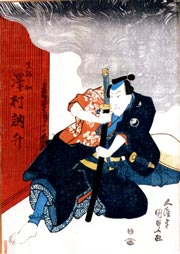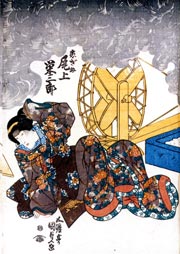| HITOTSUYA |
| Play title | Ôshû Adachi-ga-Hara |
| Authors | Chikamatsu Hanji Takeda Izumi Kitamado Goichi Takemoto Saburobê II |
| History |
Chikamatsu Hanji's play in five acts "Ôshû Adachi-ga-Hara" was originally written for the puppets theater in 1762. It was adapted for Kabuki in the 2nd lunar month of 1763 and staged at the Moritaza [casting|illustrations]. The historical background of this play is the zenkunen war, which opposed the Abe clan, ruler of the northern provinces of Japan (Ôshû), to the Minamoto clan. The latter clan, led by Minamoto no Yoriyoshi and his son Minamoto no Yoshiie, defeated the former clan, led by Abe no Yoritoki and his two sons, Abe no Sadatô and Abe no Munetô. After the war, the two sons became fugitives and the play is about their actions and their last murder attempts against their victor. The playwrights also integrated within this drama two famous Ôshû legends, the ogress of Adachi-ga-Hara and the utô bird. |
| Structure |
"Hitotsuya" is in fact made up of two scenes, "Adachi-ga-Hara Hitotsuya" (the Solitary House in the Adachi Plain) and "Adachi-ga-Hara Tani Soko" (the Bottom of the Ravine in the Adachi Plain). These scenes are the middle and last scenes of the fourth act of "Ôshû Adachi-ga-Hara". "Hitotsuya" is rarely staged. |
| Key words |
Abe Munetô Abe Sadatô Abe-shi Abe Yoritoki Adachi-ga-Hara Gidayû Kyôgen Jidaimono Kamakura Gongorô Kagemasa Minamoto Yoriyoshi Minamoto Yoshiie Ôshû Zenkunen |
| Summary |
Introduction Shigasaki Ikomanosuke was a retainer of the warlord Hachiman Tarô Yoshiie. He fell in love with the keisei Koiginu. As their love affair was illicit, the lovers were not killed by Hachiman Tarô (although they should have been executed if the samurai code was fully respected) but Ikomanosuke was excommunicated and condemned to exile. In another branch of the story, the Imperial Prince Tamaki no Miyaaki disappeared in his palace in Kyôto. The Abe brothers, whose father was killed by Hachiman Tarô, were suspected. Was it a plot to gather followers and strike back to avenge the death of their father? The Solitary House in the Adachi Plain Iwate, an old woman living in a solitary house in the desolate Adachi plain in the Ôshû Province, kills lone travelers who have asked for a night's lodging and takes their money. A girl living with the old woman comes home, accompanied by a young drug peddler, whom she met on her way home. She enters the house, leaving the young man at the door. He waits for some time but the girl does not reappear in spite of the fact that she said she would soon come out to meet him. Iwate comes to the door and tells him that the girl has already gone to bed. Pretending to go away, the young man secretly enters the house through the back entrance.Shigasaki Ikomanosuke and Koiginu come to the house to ask for a night's lodging. Koiginu, who is in the last month of pregnancy, soon suffers from stomachache. At the suggest of Iwate, Ikomanosuke goes out to buy medicine, accompanied by the old woman. While waiting for their return, Koiginu opens the door of the adjoining room and is horrified to find many skulls and bones hidden in it. Iwate comes back alone and kills Koiginu in cold blood and cuts her abdomen to take out her unborn baby. Ikomanosuke comes back and enters the house by breaking the door open. He is surprised to find Koiginu's murdered body. When he opens Iwate's room he finds her in a ceremonial robe, seated respectfully in front of Prince Tamaki. She says she is in fact the widow of Abe no Yoritoki and mother of Sadatô and Munetô. The girl living with her is in reality the lady-in-waiting Kushige-no-Naishi. As Prince Tamaki is now deaf-mute, Iwate murdered Koiginu in order to obtain the blood of an unborn baby, which is effective in curing the prince's disease. She is shocked, however, when she is informed by Ikomanosuke that Koiginu was her daughter. Iwate fills a cup with the unborn child's blood and asks Kushige to offer it to Prince Tamaki. Kushige inadvertently lets the blood fall into the ravine next to Iwate's house. As soon as the blood touches the stream at the bottom of the ravine violent waves rise from it. Kushige, who is in fact Shinra Saburô Yoshimitsu in disguise, the younger brother of Yoshiie, appears in male attire and declares that the angry waves indicate the existence of the Imperial sword of Totsuka concealed in the ravine. Moreover, Prince Tamaki is in fact Yoshiie's son Yatsuwakamaru. He has been pretending to be deaf-mute. Angry at the deception, Iwate tries to kill Yatsuwakamaru but is interrupted by the drug peddler, who in fact is Kamakura Gongorô Kagemasa, one of Yoshiie's faithful retainers, who has been sent by Yoshiie to this house to protect his son. Her plot against Yoshiie having been miserably foiled, Iwate stabs her abdomen with a sword and throws herself into the ravine. The Bottom of the Ravine in the Adachi Plain Shinra Saburô Yoshimitsu goes down to the bottom of the ravine where the body of Iwate is lying. In the valley, a torrent cuts through the rocks which cover the entire surface. Abe no Sadatô appears from behind a rock and hands to Yoshimitsu the Imperial sword of Totsuka as a token of thanks for Yoshiie's benevolence toward his brother Munetô. Yoshimitsu, as Yoshiie's proxy, cancels the excommunication of Ikomanosuke in appreciation of Koiginu's death, which has led to the recovery of the Imperial sword. The valley is surrounded by Yoshiie's troupes but Abe no Sadatô can leave it. Yoshiie and the Abe brothers will meet again on the battlefield [1]. [1] in a different version, Iwate does not kill herself in her hut but jumps into the ravine, where she meets Kushige-no-Naishi. Searching through the darkness, Kushige finds the imperial sword that had been missing. Iwate questions her for being rejoiced over the sword. Suddenly Kushige turns into a young man and reveals his real identity and the real identity of the so-called Prince Tamaki, who is in reality Yatsuwakamaru, the son of Hachiman Tarô. They were disguised so that they would recover the missing sword. Realizing that the plot has come to nothing, Iwate calls Abe no Munetô. However, the entire valley is already surrounded by Hachiman Tarô and his troops. Hachiman Tarô reinstates Ikomanosuke because of his distinguished service, and leaves Iwate and Munetô, promising to meet them again on the battlefield. |
 |
 |
 |
|
The actors Sawamura Tosshô I, Onoe Eizaburô III and Ichikawa Ebizô V playing the roles of Shigasaki Ikomanosuke, Koiginu and Iwate in the "Hitotsuya" scene of the drama "Ôshû Adachi-ga-Hara", which was staged in the 9th lunar month of 1839 at the Kawarasakiza (print made by Utagawa Kunisada I) |
||
|
|
| Contact | Main | Top | Updates | Actors | Plays | Playwrights | Programs | Links | FAQ | Glossary | Chronology | Illustrations | Prints | Characters | Derivatives | Theaters | Coming soon | News |